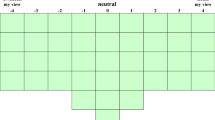Abstract
Two important content areas associated with informal environmental science programs are ecology/natural science topics and awareness of environmental problems/issues. This study attempted to evaluate which of these content areas may provide a more optimum learning experience. A quantitative analysis was conducted on two field trips to a science center that represented an ecological oriented program and an environmental issue presentation. Two variables that were chosen as indicators of program success—knowledge retention and attitude change—are outcomes that have been found prevalent in informal, environmental science education. These programs were administered and evaluated during the 1996/1997 school year at the Paul H. Douglas Environmental Science Center at Indiana Dunes National Lakeshore. The results of this study showed significant gains in science related knowledge following both the ecology and issue oriented treatments. The data indicate that the focus of the program (ecology or issues) did not significantly alter the way students responded to the knowledge section of the evaluation instrument. Results showed little impact on students' affect toward park site or related subject matter following either presentation type. Authors recommend multiple research methods to better evaluate affect changes following an informal environmental science experience.
Similar content being viewed by others
REFERENCES
Bitgood, S. (1989). School field trips: An overview. Visitor Behavior 4: 3–6.
Cable, T. T., Knudson, D. M., and Theobald, W. F. (1986). The application of the theory of reasoned action to the evaluation of interpretation. Journal of Interpretation 11: 11–25.
Dori, Y. J., and Tal, R. T. (2000). Formal and informal collaborative projects: Engaging in industry with environmental awareness. Science Education 84: 95–113.
Drake, T., and Knapp, D. H. (1994). The hilltop interpretation project. The Interpretive Sourcebook (The Proceedings of the 1994 National Interpreters'Workshop), Omnipress, Madison, WI, pp. 282–292.
Falk, J. H. (1983). Field trips: A look at environmental effects on learning. Journal of Biological Education 17: 137–142.
Falk, J. H., and Balling, J. D. (1982). The field trip milieu: Learning and behavior as a function of contextual events. Journal of Educational Research 76: 22–28.
Flexer, B. K., and Borun, M. (1984). The impact of a class visit to a participatory science museum exhibit and a classroom science lesson. Journal of Research in ScienceTeaching 21: 863–873.
Gramann, J. H., and Vander Stoep, G. A. (1987). Prosocial behavior theory and natural resource protection: A conceptual synthesis. Journal of Environmental Management 24: 247–257.
Ham, S. (1986). Social program evaluation and interpretation: A literature review. In Machlis, G. (Ed.), Interpretive Views, National Parks and Conservation Association, Washington, DC, pp. 9–38.
Independent Commission on Environmental Education. (1997, April). Are we Building Environmental Literacy? Author, Washington, DC.
Isaac, S., and Michael, W. B. (1990). Handbook in Research and Evaluation, Edits, San Diego, CA.
Knapp, D. H. (1994). Validating a framework of goals for program development in environmental interpretation, unpublished doctoral dissertation, Southern Illinois University, Carbondale.
Knapp, D. H., and Barrie, E. (1998). Ecology vs. interpretation: The analysis of two different messages. Journal of Interpretation Research 3: 21–38.
Koran, J. J., Koran, M. L., and Ellis, J. (1989). Evaluating the effectiveness of field experiences: 1939-1989. Visitor Behavior 4: 7–10.
Lisowski, M., and Disinger, J. F. (1988). Environmental education research news. The Environmentalist 8: 3–6.
Lisowski, M., and Disinger, J. F. (1992). The effect of field-based instruction on student understandings of ecological concepts. Journal of Environmental Education 23: 19–23.
Lucas, K. B. (2000). One teacher's agenda for a class visit to an interactive science center. Science Education 84: 524–544.
Marsan, S., and Knapp, D. H. (1996). The deam wilderness interpretive program. Interpedge 3: 20–25.
McClafferty, T., and Rennie, L. (1992, July). Learning and Rallying in Science Education Centers and Science Museums. Paper presented at the Australian Science Education Research Association Conference, Canberra, Australia.
Meredith, J. E., Fortner, R. W., and Mullins, G. W. (1997). Model of affective learning for informal science education facilities. Journal of Research in Science Teaching 34: 805–817.
National Science Resources Center. (1993, Spring). Assessment in STC units. National Science Resources Center Newsletter, pp. 2–3.
Nazier, G. L. (1993). Science and engineering professors: Why did they choose science as a career? School Science and Mathematics 93: 321–324.
Orion, N. (1993). A model for the development and implementation of field trips as an integral part to the science curriculum. School Science and Mathematics 93: 325–331.
Ramey, L.G., Walberg, H. J., and Walberg, H. J. (1994). Reexamining connections: Museums as science learning environments. Science Education 78: 345–363.
Rennie, L. J., and McClafferty, T. (1995). Using visits to interactive science and technology centers, museums, aquaria, and zoos to promote learning in science. Journal of Science Teacher Education 6: 175–185.
Roggenbuck, J.W., Hammitt, W. E., and Berrier, D. L. (1982). The role of interpretation in managing for recreational carrying capacity. Journal of Interpretation 7: 7–20.
Rudmann, C. L. (1994). A review of the use and implementation of science field trips. School Science and Mathematics 94: 138–141.
Ryan, C. (1991). The effects of a conservation program on school children's attitudes toward the environment. Journal of Environmental Education 22: 30–35.
Sneider, C., Eason, L., and Friedman, A. (1979). Summative evaluation of a participatory science exhibit. Science Education 63: 25–36.
Author information
Authors and Affiliations
Rights and permissions
About this article
Cite this article
Knapp, D., Barrie, E. Content Evaluation of an Environmental Science Field Trip. Journal of Science Education and Technology 10, 351–357 (2001). https://doi.org/10.1023/A:1012247203157
Issue Date:
DOI: https://doi.org/10.1023/A:1012247203157




